Top Techniques for Sparkling Shower Glass Doors

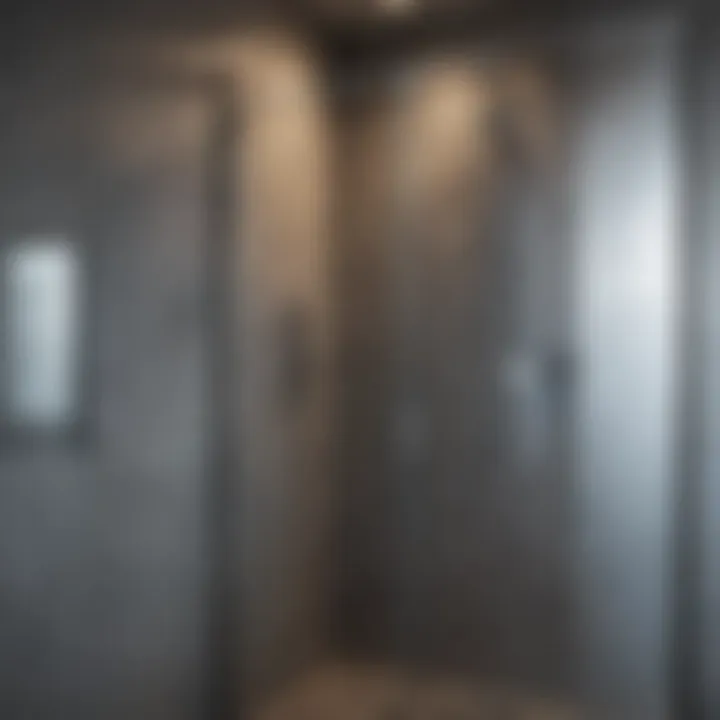
Intro
A clear and sparkling shower glass door can truly enhance the look of any bathroom. It's one of those finishing touches that can make your whole space gleam. However, getting that pristine appearance might feel like a never-ending chore. Water stains, soap scum, and grime are pesky visitors that don’t seem to understand your invitation to keep the shower clean. As a homeowner, it's essential to have effective methods at your disposal to tackle these challenges head-on. This guide will delve into various solutions ranging from household items to specialized cleaning agents. We’ll break it down step by step, ensuring that your shower glass door remains a highlight, rather than a hidden embarrassment.
Design Inspiration
Trending Styles
In today's home design, bathroom aesthetics are just as critical as functionality. One popular trend is creating a spa-like retreat, where clear glass shower doors play a starring role. These doors not only serve as a barrier but also offer a sense of openness. Frameless shower doors are particularly in vogue, giving an unobstructed view and an airy feel to the room. Homeowners are increasingly opting for large walk-in showers with sleek glass doors that invite all the light into the space.
Color Palettes
When considering your bathroom design, the right color palette can make or break the visual appeal. Soft whites and neutral tones work wonders, creating tranquility and elegance. Paired with shiny chrome or brushed nickel fixtures, a glass door stands out, making the space feel modern yet inviting. Meanwhile, deeper hues like navy blue or forest green can add drama, giving a more luxurious ambiance when combined with clear glass. Keeping these design elements in mind while maintaining the cleanliness of your shower glass is crucial to ensure everything looks cohesive.
Practical Tips
Maintenance & Care
Routine cleaning is essential to keep those water stains at bay. Try using a squeegee after every shower. It might feel like a bit of an added chore, but it keeps your glass looking clear longer. For a deeper clean, consider mixing equal parts white vinegar and water in a spray bottle. Spritz the solution, let it sit for about ten minutes, and wipe it clean with a microfiber cloth. This method combats soap scum effectively and deals with hard water spots.
Budgeting & Planning
You don't have to break the bank to keep your shower glass door spotless. When budgeting for cleaning supplies, keep the focus on natural options first. Baking soda can be a surprising ally; sprinkle it on a damp cloth to scrub away stubborn stains. If you're leaning toward commercial products, look for those specifically tailored for glass surfaces. In the long run, investing in quality items can save you money by reducing the frequency of your cleanings.
"A clean shower isn't just about aesthetics; it's a step towards better hygiene that can’t be overlooked."
Understanding Shower Glass Doors
Understanding shower glass doors is not just about their aesthetic appeal; it touches on their functionality and maintenance. The type of glass, its framing, and the associated maintenance challenges all contribute to how a bathroom feels and functions. A clean, well-maintained shower glass door enhances the overall visual of a bathroom, making it inviting and refreshing. Knowing the nuances of shower glass types helps homeowners make informed decisions in both purchase and cleaning routines.
Types of Shower Glass
Framed vs. Frameless
When it comes to the framed versus frameless debate, what stands out is the design impact on bathroom aesthetics. Framed shower doors are typically surrounded by aluminum or metal frames. This reinforcement not only provides structure but also often makes installation easier. They tend to be more affordable and can be particularly advantageous in older homes or bathrooms that need extra support.
On the other hand, frameless shower doors are all the rage for modern designs. Their key characteristic is the absence of a bulky frame. Instead, they utiliz sleek hardware, which makes the bathroom feel larger and more open. This unique feature is not just visually striking but also allows for easier cleaning since there are fewer crevices for grime and soap scum to gather. However, frameless doors come with a heftier price tag and may require more intricate installation.
In essence, both options have their merits. Framed doors offer stability and affordability, while frameless doors bring a chic, contemporary vibe that can elevate any bathroom.
Clear vs. Frosted Glass
Next up is the choice between clear and frosted glass. Clear glass shower doors let in maximum light and provide an unencumbered view, creating a sense of spaciousness. This is particularly beneficial for smaller bathrooms as it can visually expand the area. The downside is that clear glass tends to show stains and water spots more readily. Regular maintenance is needed to keep them looking pristine.
On the flip side, frosted glass provides more privacy, making it a popular choice for shared bathrooms or those located near guest areas. The frosted surface disguises water stains and soap residues better, making maintenance somewhat easier. However, it might not allow as much light in, potentially making a bathroom feel dimmer.
The choice between clear and frosted glass largely depends on personal preference, bathroom size, and the level of privacy one desires, each with its unique advantages in cleaning and appearance.
Common Issues with Shower Glass
Soap Scum Build-up
Soap scum is a significant concern for many homeowners. This stubborn residue forms when soap combines with water minerals and settles on surfaces. Its primary contribution to this article is highlighting the importance of regular cleaning. Without intervention, soap scum can become a challenging and unappealing issue, turning a once-clear shower door into a haze of muddied glass. One identified benefit is that if addressed early, soap scum can be cleaned easily with simple solutions, but if left too long, it may require more aggressive methods.
Water Stains
Water stains are another common headache, particularly in areas with hard water. These stains appear as whitish spots or streaks and can build up quickly. The challenge here is not just cosmetic; left unchecked, water stains can lead to mineral deposits that may damage the glass over time. They highlight the necessity for consistent cleaning practices to preserve the life of shower glass doors. Addressing water stains repetitively can seem tedious, yet, maintaining a routine can save significant time and resources down the line.
Mold and Mildew Growth
Mold and mildew growth can present serious health hazards, often thriving in the damp environment of bathrooms. This common problem poses recognition challenges, especially on clear glass, as it can easily be overlooked until it spreads. The key characteristic of this issue is moisture; controlling it is essential not just for aesthetics but also for maintaining a healthy atmosphere. It reinforces the argument for using well-ventilated and regularly cleaned showers, as prevention is certainly less labor-intensive than remediation.
"Staying ahead of these common issues is critical—not only for the cleanliness of your bathroom but for your overall health."
In summary, knowing the distinctions between shower glass types and the challenges they can present emphasizes the commitment to maintaining them. Each factor plays a crucial role in ensuring your shower glass door remains a sparkling centerpiece in your bathroom.
Essential Cleaning Supplies
When it comes to cleaning your shower glass door, the right cleaning supplies can make all the difference. You’re not just looking at a shiny surface; you want tools and solutions that do the job efficiently and effectively. The thing is, choosing the right supplies can save time and effort. Plus, it helps you maintain the hygiene of a space that often gets neglected.
Understanding the significance of essential cleaning supplies is vital. They can determine the efficacy of your cleaning approach, offering convenience and high-quality results. Balancing the use of natural products with some commercial options gives you versatility. Each type brings its unique strengths to the table, enabling a comprehensive cleaning regimen.
Natural Cleaning Solutions
Natural cleaning agents are gaining traction in households seeking to reduce chemical exposure. Here are three powerful contenders:
Vinegar
Vinegar is a standout in the realm of natural cleaning agents. Renowned for its acidity, it easily breaks down mineral deposits and soap scum. Not only does it clean effectively, but it's also eco-friendly. The unique feature of vinegar lies in its ability to tackle odors while disinfecting surfaces.
Advantages include:
- Non-toxic: Safe for humans and pets.
- Cost-effective: A common household item, often cheaper than commercial cleaners.
However, there are some downsides; its strong smell can be off-putting to some. But once the area aerates, the odor dissipates rapidly.
Baking Soda
Baking soda is like the unsung hero in cleaning. Known for its abrasive properties, it helps scrub away tough stains without scratching the glass. It’s often used alongside other solutions to enhance cleaning power. The versatility of baking soda shines through when combined with vinegar, creating a foaming reaction that lifts grime reliably.
Key characteristics:
- Gentle abrasive: Effective without causing damage to the surfaces.
- Deodorizing powers: Completely removes unpleasant odors.
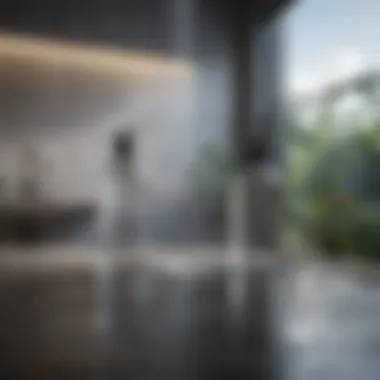
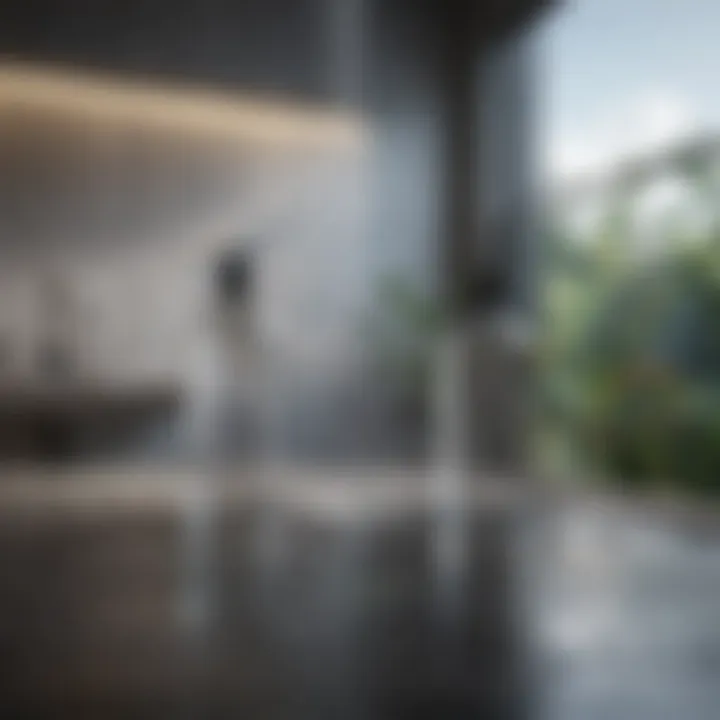
Although, it does require some elbow grease for stubborn spots. But hey, a little effort goes a long way toward a sparkling clean!
Lemon Juice
Lemon juice will tickle your taste buds but it's also a fierce cleaner. Its natural acidity not only fights bacteria but also leaves a fresh scent behind. The bright acidity of lemon makes it great for combating hard water stains as well, making it a popular choice in many households.
What makes it special:
- Natural disinfectant: Kills various strains of bacteria.
- Pleasant fragrance: Leaves your glass smelling fresh post-cleaning.
However, the citric acid can erode certain finishes over time, which is something to watch out for. Always apply it carefully, especially if you have delicate surfaces in your bathroom.
Commercial Cleaners
If convenience is your game, commercial cleaners can be your best ally. These products are designed to tackle tough stains quickly. Here’s a closer look:
Spray Cleaners
Spray cleaners are particularly popular for their ease of use. Just spray, wait, and wipe – it’s that simple. The formulation typically targets soap scum and water stains, providing instant results. Many users appreciate the immediate gratification they get from using these products.
Things to note:
- Variety of formulations: Options exist for different types of stains.
- Time-saving: Minimal scrubbing often required.
On the flip side, some may contain harsh chemicals, so it’s wise to read labels to ensure safety around kids and pets.
Gel Cleaners
Gel cleaners offer another layer of convenience with their thick viscosity, ensuring they cling to surfaces longer. This leads to enhanced cleaning power, especially for stubborn and dried-on stains. They work well on vertical surfaces, reducing the risk of dripping.
Noteworthy aspects include:
- Longer contact time: Greater efficacy with tough stains.
- Less wastage: The gel persists, unlike liquid cleaners that can run off.
However, users may find costlier options, which could lead to some exceptions in budget constraints.
Tools for Effective Cleaning
The right tools can be the backbone of your shower cleaning routine. Consider these:
Squeegees
Squeegees are a staple in any cleaning arsenal. Used after each shower, they help eliminate water spots before they can set in. A reliable squeegee can simplify post-shower maintenance and prolong the time between deep cleanings.
Key benefits:
- Prevents soap scum buildup: Eases the overall cleaning process.
- Inexpensive and easy to use: A small investment yields big returns in cleanliness.
However, if neglected, a squeegee can harbor mold itself, so good maintenance is essential.
Microfiber Cloths
Microfiber cloths are phenomenal for polishing and drying surfaces without scratching them. Their ultra-fine fibers capture dirt, dust, and microorganisms effectively. They’re rewashable, making them an eco-friendly choice.
Notable characteristics include:
- Highly absorbent: Holds several times its weight in liquid.
- Durable: Long-lasting compared to traditional cloths.
The downside? They require special care to maintain their absorbency, a small price to pay for their effectiveness.
Scrub Brushes
Scrub brushes can match the might of any tough spot on your glass. Their bristles can help dislodge dirt and stains in hard-to-reach areas. For glass doors that have seen better days, having a scrub brush handy packs a powerful punch.
Advantages are:
- Variety of bristle stiffness: Options exist for gentle to tough scrubbing tasks.
- Versatile usage: Works well on other bathroom surfaces too.
But choose wisely; using too harsh a brush can pit or scratch glass surfaces, so softer bristles are often favored.
By gathering the right cleaning supplies, whether they be natural, commercial, or tools, you're setting the stage for a successful cleaning experience. The combination of effective products and adequate techniques helps ensure that your shower glass door remains sparkling clean, making your bathroom a more pleasant space.
Preparing for Cleaning
Preparing your space before diving into the cleaning process is a crucial step that many homeowners overlook. Without proper preparation, even the best cleaning methods can fall flat. By ensuring that you have the right environment and supplies, you can significantly enhance the efficacy of your cleaning efforts while also ensuring your own safety. This section covers the essentials you need to consider before scrubbing those glass doors to a shine.
Safety Precautions
Before you grab that spray bottle, it's wise to consider your safety. Cleaning products, whether natural or commercial, can sometimes release fumes or irritate skin. Taking a few simple precautionary measures can help you navigate this process with ease.
Wearing Gloves
Wearing gloves is one of the most basic yet crucial steps in maintaining safety while cleaning your shower glass door. It’s all about protecting your skin from harsh chemicals. Many cleaning solutions contain ingredients that can cause irritation or allergic reactions, especially when frequently exposed.
What makes gloves a popular choice? Their ability to create a barrier between your skin and the cleaning agents is a significant advantage. You'll not only safeguard your hands but also maintain a better grip on your cleaning tools without the hassle of direct contact with grime.
However, it's crucial to choose gloves made specifically for cleaning—those that can withstand chemicals without breaking down over time. If you aren't careful, using the wrong type can lead to unwanted rips or tears, exposing your skin to possible irritants.
Ventilating the Area
Ventilating the area while cleaning may seem like a no-brainer, yet it’s often neglected. Proper airflow significantly contributes to reducing fumes and preventing you from breathing in harsh chemicals. This is crucial any time you’re using commercial cleaners that might have strong scents or potentially harmful vapors.
So why is this step considered beneficial? It helps ensure that the air remains fresh, which can also enhance your comfort while cleaning. A well-ventilated space can lessen the likelihood of headaches or dizziness that might accompany inhaling cleaning agents. Ventilating your bathroom involves simply cracking a window or turning on an exhaust fan if available. However, do keep in mind that if it’s particularly cold outside, you may want to limit the duration of ventilation to avoid chilling off the space too much.
Removing Personal Items
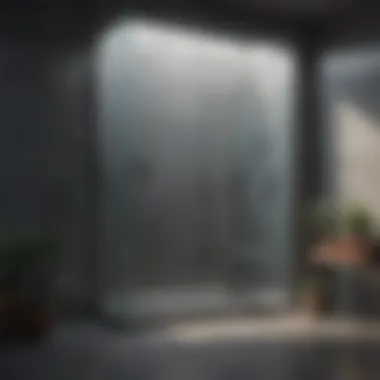

Once safety measures are in place, the next order of business is clearing the area of personal items. This ensures that you can clean effectively without hindrance. Moreover, leaving items around can risk damaging them from cleaning sprays.
Clearing the Shower Area
Clearing the shower area is all about creating a clean canvas for your cleaning process. It allows you to get to every nook and cranny while eliminating the possibility of damaging personal hygiene products or decorative items.
Highlighting the key characteristic here: elimination of clutter. By tidying up, you not only make the cleaning process easier but also create an inviting atmosphere for the next time you step into the shower.
Additionally, removing items reduces the chances of slippery surfaces caused by spills from various cleaning agents. It’s a simple yet effective way to lower risks and guarantee a focused cleaning session.
In the end, these preparatory steps may feel like a hassle, but they lay the groundwork for effective and safe cleaning. Taking the time to prepare ensures that your shower glass door not only sparkles but that the process itself is smooth and hazard-free.
Step-by-Step Cleaning Process
Cleaning your shower glass door isn’t just about making it look nice. The process helps maintain hygiene and prevents the build-up of minerals and soap residues. A well-maintained door not only enhances the appearance of the bathroom but can also extend the life of the glass. Therefore, following a thorough step-by-step approach is crucial. This section will delve into the specific actions needed to achieve optimal results when cleaning, breaking down each phase for efficiency and effectiveness.
Applying Cleaning Solution
Even Coating Techniques
Applying a cleaning solution evenly across the surface of your shower glass is essential for tackling dirt and grime efficiently. An even coat allows the solution to work effectively without missing those stubborn spots that might make you pull your hair out. One significant characteristic of this technique is that it helps to maximize the contact area of the cleaner with the glass, ultimately making cleaning easier.
You might find using a spray bottle or a clean cloth soaked in the solution is beneficial here. This method ensures that every inch of the glass receives appropriate attention. Nonetheless, a drawback can be over-saturation, which may lead to dripping and create a mess to clean later.
Soaking Time for Stains
Once the solution is applied, letting it sit for a predetermined soaking time is crucial to tackle tougher stains, especially those water spots and soap scum. The key characteristic of soaking is that it softens the residues, making them far easier to wipe away. This approach promotes better cleaning efficiency by ensuring any hard stains don't stand a chance against your scrubbing.
You typically want to let the solution sit for about 5-10 minutes, depending on the severity of the stains. However, you must also be careful not to leave the solution too long, as certain cleaners can damage the glass. Thus, timing is important; it can mean the difference between a sparkling door or one marred by harsh chemicals.
Scrubbing the Glass
Using Appropriate Tools
Choosing the right tools for scrubbing is paramount. Using a soft, non-abrasive scrub brush or sponge can significantly contribute to the cleaning process, providing just the right amount of friction without scratching the glass. The elegance of this choice is that it gets into the nooks and crannies of the glass surface without leaving scratches, making it popular for homeowners looking to maintain glass easily.
However, it's essential to steer clear of steel wool or harsh sponges, as they can lead to irreversible damage. A poor tool choice can turn a cleaning effort into a disaster, resulting in unattractive glass and more work down the line.
Technique for Scrubbing Tough Spots
When it comes to stubborn spots, a bit of care goes a long way. The technique should involve gentle circular motions combined with varying pressure. This approach enhances the effectiveness, especially for tough stains that have built up over time. A unique feature of this method is its blend of pressure; applying too much force can lead to wear on the glass, while too little might result in wasted effort.
In terms of disadvantages, patience is often needed because tough stains may not disappear immediately. However, with consistency and the right approach, even the toughest cling-on stains will eventually give way to a gleaming surface.
Rinsing and Drying
Thorough Rinse Techniques
Once you've scrubbed the glass surface, rinsing it properly is the next crucial step. This process ensures all cleaning agents are washed away, preventing any residue buildup that could attract dirt later on. A key element to thorough rinsing is using warm water, as it can help dissolve any remaining soap or cleaner.
Using a hand-held shower nozzle can simplify this process dramatically. Its flexibility allows you to control the water flow, making it easier to direct where the rinse goes. The downside to this could be inconsistent rinsing, so be mindful to cover all areas thoroughly.
Optimal Drying Methods
Finally, after rinsing, how you go about drying the glass can make all the difference. Using a microfibre cloth is generally the go-to method, as it absorbs moisture effectively without leaving streaks. This method is favored because it ensures that your shower glass retains its transparent charm without unsightly spots.
A handy tip for efficiency is to dry the door immediately after rinsing. However, if left too long, water spots can settle back onto the glass, which can lead to frustrating re-cleaning later. It's a balance of timing and technique—get it right, and your glass will shine like new.
Post-Cleaning Care
After putting in the elbow grease to scrub down your shower glass door, it’s vital to give some thought to the ongoing care of your efforts. Post-cleaning care is essential as it not only helps maintain the sparkle of your glass door but also prevents the recurring headaches of grime and stains. Taking a few extra minutes each week can save you from hours of battling built-up soap scum and mineral deposits later on.
Maintaining Cleanliness
Regular Cleaning Schedule
A regular cleaning schedule is like a consistent diet; it keeps things in shape. Setting aside just a few minutes each week to clean your shower glass can significantly impact its overall appearance. This proactive approach helps in catching minor stains before they turn into daunting problems.
One of the key characteristics of maintaining a regular cleaning schedule is its simplicity. You won’t have to dread a big cleaning session when you make it a routine activity. Often viewed as a beneficial strategy for homeowners, regular cleaning is not just about tidiness—it's also about promoting hygiene and preventing harmful mold growth.
A unique feature of sticking to a schedule is that it builds a habit. The more you do it, the easier it becomes. However, the downside might be the discipline it demands. It can feel monotonous, but in the long run, the advantages overshadow the temporary tedium.
Daily Wipe Down Practices
Integrating daily wipe down practices into your routine can act as a guard rail to maintain cleanliness. This quick fix can stave off stubborn stains and keep those water marks at bay. Think of it as the "preventative medicine" for your shower glass—like taking vitamins to enhance your overall health.
The key characteristic of daily wipe down practices is their efficiency. Just a few minutes—sometimes less—is all it takes to ensure a clearer view. Many homeowners find daily wipe downs a popular choice because they’re simple, quick, and they have a noticeable impact on glass clarity.
A unique aspect of this daily ritual is that it’s customizable. You can use a soft cloth or a squeegee, whichever feels more comfortable for you. The downside can be that it requires you to remember this task amidst your busy routine, but honestly, adding it can be as easy as just grabbing a cloth after your shower.
Dealing with Persistent Stains
Identifying Stain Types
Knowing the type of stain you’re dealing with can make all the difference in tackling it effectively. Recognizing stain types—like hard water stains, soap scum, or mildew—allows you to select the right product and technique.
An important characteristic of identifying stains is how it empowers you. Knowledge is indeed power, and knowing exactly what you’re up against can shift any DIY project from overwhelming to manageable. Homeowners often find this approach beneficial, as it helps them make informed decisions rather than playing a guessing game.
The unique feature of identifying stains lies in its long-term advantage. Once you know how to recognize different stains, you’ll save time on treatments and may even avoid the need for harsh chemicals. Mistaking a mild soap residue for a serious problem could lead to unnecessary hassle and expense.
Choosing the Right Products
Picking the right products for cleaning can be a revelation. With countless options available, choosing effectively means reducing the time and effort needed to get that glass shining again. Whether you prefer natural solutions like vinegar or commercial ones like Windex, understanding your options is key.
One of the significant characteristics of this decision-making process is achieving targeted results. Choosing the right product tailored to specific stains ensures you don’t waste time trying out various cleaners that may not work effectively. This thoughtful approach is well-regarded among homeowners who value efficiency, making it a popular topic in cleaning forums.

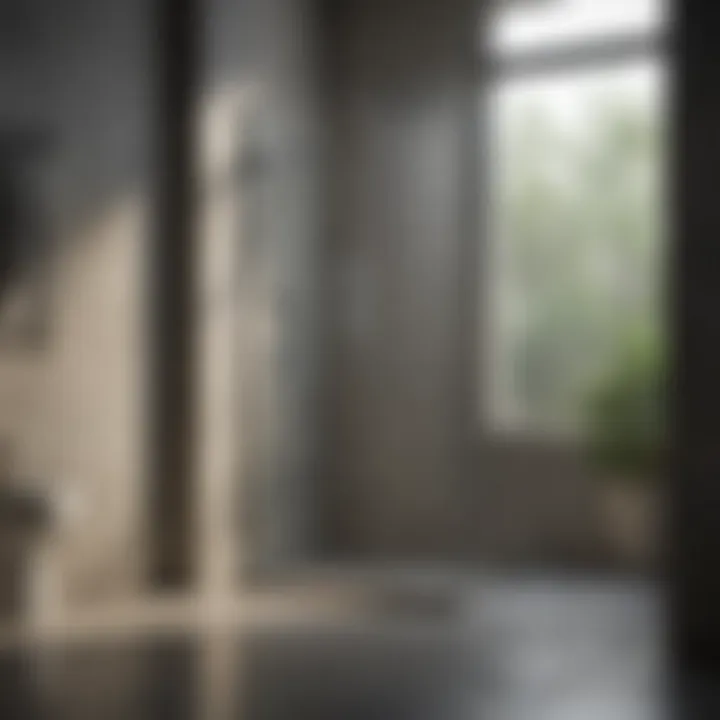
A unique feature of this aspect is the versatility of choices available. Different stains might necessitate different cleaning agents. On the downside, trying multiple products could lead to some confusion or frustration if they don’t work as expected. However, once you find the right fit, it can make cleaning feel a lot less like a chore and more like you’re just "taking care" of your home.
Preventative Measures
In any home, cleanliness often goes hand in hand with regular maintenance. This can’t be truer when it comes to shower glass doors. Preventative measures are essential, not just for keeping your shower looking spick and span, but also for increasing the lifespan of the glass. By taking some basic steps, homeowners can save themselves from the hassle of deep cleaning every few weeks and avoid potential damage that can arise from neglect.
Water Softening Solutions
Installing a Water Softener
Hard water is a common headache for many homeowners. It leaves stubborn mineral deposits on glass surfaces that can be tough to remove. Installing a water softener can be a game changer. This system removes minerals that cause hard water, reducing their presence significantly in your shower.
One of the key characteristics of a water softener is its ability to not only soften the water, but also enhance the effectiveness of soaps and detergents. This means, you will use less product while achieving better results. A noteworthy advantage of soft water is that it will help maintain the clarity of your shower glass. However, not all systems are the same. They come at various price points and some might require additional maintenance—a consideration worth factoring in.
Using Shower Filters
Another route to tackle hard water issues is utilizing shower filters. These devices sit right at the source and can purify the water before it even reaches your glass door. Their iconic feature is their ability to remove chlorine and other discolouring agents from your water.
The benefit of shower filters is their ease of installation—most models simply screw on without any specialized equipment. One downside could be the need to replace the filter cartridge regularly; however, many find this small inconvenience outweighed by the advantages—particularly the reduction of buildup on shower glass doors.
Using Protective Coatings
Application of Glass Sealants
When discussing preventative measures, applying glass sealants must take center stage. This process involves coating the glass with a protective layer that repels water and prevents grime from adhering too tightly. The key feature of glass sealants is their durability—they can last several months before needing a reapplication.
The clear advantage here is that by making the glass hydrophobic, the shower door becomes easier to wipe down after each use. On the flip side, preparation is essential; if the glass isn’t thoroughly cleaned before application, the sealant might not adhere properly, creating more problems than solutions.
Benefits of Protective Films
Protective films are another innovative solution. Unlike sealants, these films offer an additional shield against scratches and more severe damage. What makes protective films appealing is their versatility—they come in various finishes and can be used on a range of surfaces beyond just shower doors.
One unique feature is that they are removable, providing a chance to inspect the glass condition beneath. However, the downside is that they may not last as long as sealants, requiring occasional replacement. Nevertheless, for the conscientious homeowner, they serve as a solid line of defense against the daily wear and tear in this often-used space.
By incorporating preventative measures, homeowners can maintain the gleam of their shower glass doors while ensuring easier cleaning routines in the long run.
Troubleshooting
Troubleshooting is an essential component of maintaining shower glass doors, as it focuses on diagnosing and resolving common cleaning issues that arise in this specific area. By understanding how to identify problems such as frequent stains or hard water deposits, homeowners can tackle these challenges effectively. Ignoring these issues can lead to further damage, ultimately costing more in repairs or replacements.
In every home, the shower bears the brunt of daily use, which means that its glass doors are prone to various blemishes and buildup. Having a proper troubleshooting strategy can empower homeowners to take swift action against these annoyances, ensuring their glass doors remain clear and sparkling.
Identifying Problem Areas
Frequent Stains
Frequent stains are those annoying marks that appear on your glass door, often caused by soap residue, body oils, or even the minerals found in your water supply.
These stains contribute to the overall cleanliness and appearance of your bathroom. If left unattended, they can become stubborn and hard to remove. One key characteristic of frequent stains is their recurring nature; they don’t just vanish overnight and need regular attention to keep at bay.
A unique feature of these stains is their ability to sometimes change color or intensity depending on the products you use in the shower or even the water's mineral content. The advantage of recognizing these stains early is that they can be addressed with simple cleaning methods, saving time and effort in the long run. But if they get too embedded, more aggressive cleaning solutions might be necessary.
Hard Water Deposits
Hard water deposits are a notorious issue in many households. They form when water containing high levels of calcium and magnesium evaporates, leaving behind a chalky residue on your glass door.
These deposits are often white or cloudy, making them a key visual indicator that something needs to be done to maintain the clarity of your shower glass. Their prevalence makes them a significant topic in this article, as many homeowners face this pesky problem regularly.
The unique aspect of hard water deposits is that they can gradually etch into the glass over time if not dealt with promptly. Possible methods for addressing them range from natural solutions like vinegar to specialized commercial cleaners. It’s essential to be proactive since neglecting these deposits can lead to long-term damage that may necessitate replacement rather than cleaning.
When to Seek Professional Help
Severe Damage
Severe damage refers to situations where the glass door is cracked, shattered, or has prominent scratches. Such problems not only affect the aesthetic appeal of your bathroom but also can impact safety.
Recognizing severe damage is crucial because no home remedy or DIY solution would be appropriate in this scenario. Hiring a professional to assess the damage can offer several advantages, such as ensuring that the issue is resolved correctly without further harm. This choice is beneficial since a replacement may sometimes be necessary, and a professional can advise on the best course of action.
Difficult-to-Reach Areas
Difficult-to-reach areas are spots that are hard for a homeowner to clean effectively, such as corners or high sections of the shower door. These spaces can harbor grime and stains, often leading to a lackluster look for the entire unit.
The main characteristic of these areas is their accessibility; they typically require extensions or special tools to clean properly. This makes it a wise consideration to seek professional help if grime accumulates in these locations. Engaging a professional cleaner ensures that no surface is missed and that all areas reflect the care that is vital to good bathroom maintenance. Also, tackling tough spots can prevent larger cleaning challenges in the future, which translates to a cleaner, healthier environment overall.
"Taking proactive measures to understand and address these issues can turn a daunting task into a manageable aspect of home care."
In summary, troubleshooting can offer homeowners valuable insight into maintaining shower glass doors, heightening both aesthetics and hygiene. By familiarizing themselves with frequent stains and hard water deposits, residents can extend the lifespan of their glass doors, while understanding when to call in professionals can be a decisive factor in upholding the integrity of their bathrooms.
Culmination
Cleaning your shower glass door might seem like a mundane task, yet it carries significant weight in maintaining your overall bathroom hygiene and aesthetics. A sparkling glass door not only enhances the beauty of your shower space, but it also prolongs the life of the glass, helping to prevent etching and permanent stains from hard water or soap scum.
Summary of Methods
To have a clear, gleaming glass door, it’s important to understand the variety of cleaning methods available. Here’s a quick recap of some effective techniques:
- Natural Solutions:
- Commercial Cleaners:
- Tools:
- Vinegar and baking soda can work wonders, cutting through grime while being eco-friendly.
- Lemon juice not only cleans but leaves a fresh scent behind.
- Spray cleaners are great for quick jobs, while gel cleaners can stick to vertical surfaces for extended cleaning time.
- High-quality squeegees are essential for preventing water stains.
- Microfiber cloths are excellent for polishing without scratching.
Together, these solutions create a powerful toolkit to tackle even the most stubborn buildup.
Final Thoughts on Shower Care
In closing, caring for your shower glass door is about more than just a cleaner surface. It’s about creating an inviting space that complements your home’s design and contributes to your overall well-being. Consistency is key; regular maintenance will save ample time and effort in the long run. Furthermore, employing preventative measures—like using a squeegee after each shower or investing in water softeners—can mitigate issues before they arise.
Ultimately, with the right approach and materials, you can maintain a harmonious atmosphere in your bathroom while keeping your shower glass door sparkling clean, reflecting your dedication to both cleanliness and aesthetics.















